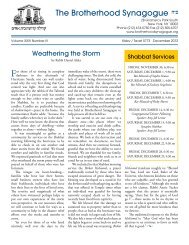Creating Leaders - The Brotherhood Synagogue
Creating Leaders - The Brotherhood Synagogue
Creating Leaders - The Brotherhood Synagogue
You also want an ePaper? Increase the reach of your titles
YUMPU automatically turns print PDFs into web optimized ePapers that Google loves.
<strong>Creating</strong> <strong>Leaders</strong>Re-<strong>Creating</strong> Reality
I knew it was not simple nor easy andthat any person who pursues the easy pathshould not choose this way, but for thosewho have G-d in their heart, who have thepassion and the ability to participate in thecreation of (a new nation) – this is the pathto follow.David Ben-Gurion, Sde Boker, 1955THE ISRAEL LEADERSHIP INSTITUTE<strong>The</strong> goals of <strong>The</strong> Israel <strong>Leaders</strong>hipInstitute (ILI) were carefully definedby the founders of this non-profiteducational institute. <strong>The</strong>ir commitmentto the secured future of Israel inspired them toinvest in the development of future generation of leadersof the State. <strong>The</strong>y realized that by preparing a cadre ofyoung talented Israelis, by facilitating their integrationinto the national mosaic of leadership and by empoweringyoung talented Jewish leaders throughout the Jewishworld, they could promise a better future for Israel andfor the world. <strong>The</strong>y understood that the potential foundin many young motivated Israeli men and women couldserve as an engine for the creation of an Israeli societyas a dynamic source of power contributing to Jewsthroughout the world.Committed to the development of the future leadership,our founders perceived this as part of the Renaissanceof the Jewish people in our historic homeland and as amean of strengthening the bond with our fellow Jews inthe Diaspora. ILI conducts educational programs in thefield of public leadership and the integration of ourgraduates over time, to meet society's changing needsand prepare for future challenges.Israel, in its seventh decade, unfortunately finds itselfin the midst of a leadership crisis. Together with othermembers and partners we have developed a practicalprogram aimed in resolving this crisis. We have launcheda unique project which its goal is to find a solution forthe Israeli leadership crisis. Some of Israel's exceptionalscholars and leading public figures have joined togetherin this mission to nurture and guide our future leaders.We chose the town of Sderot in the south of Israel as ahome for our institute, well realizing that the locationcarries a strong moral message.<strong>Creating</strong> <strong>Leaders</strong>Re-<strong>Creating</strong> RealityILI'S LEADERSHIP TEAM INCLUDES THEFOLLOWING MEMBERS:Al Schwimmer,FounderGalia Albin,Senior BODmemberBrigadier General (Res.)Oded Tyrah,Eeki Elner,Founder &Chairman Executive DirectorMK (Ret.)Ilan Leibovitz,Senior BODmemberMajor General (Res.)Eyal Ben-Reuven,Senior BODmemberEyal Arad,Senior BODmemberBrigadier General (Res.)Gal Hirsch,Senior BOD memberProf. NitzaNachmias,DeanOUR MISSION<strong>The</strong> Israel <strong>Leaders</strong>hip Institute is a powerful beacon oflight bringing hope for a nation faced by continuousdaily threats to its very existence and still strugglingwith numerous social hardships.ILI is fully committed to identifying, training, equippingand nurturing the future generation of young Israelileaders, based on Zionist and Biblical values and adaptedto our modern world and the changing times. ILI proudlybears the responsibility for the complete integration ofour graduates into the Israeli leadership arena. ILI hasdeveloped a complete and unique extension of ourleadership curriculum enabling our graduates tocontribute their skills and experience to society as awhole. At the same time, this unique leadership-trainingprogram shall be implemented and incorporated, both inIsrael and abroad, into corporations, congregations andacademic channels. This shall serve as a focal point forbringing together Jewish communities worldwide andfor encouraging closer cooperation between Israeli andJewish leaders in many areas.
International Journal of Soft Computing and Engineering (IJSCE)ISSN: 2231-2307, Volume-2, Issue-3, July 2012Shows the files downloaded in the Scratch Space and Shareswith all nodes of that particular channel.D. Bandwidth ManagementEach participating node joins a clique, which is a group ofsensors that measure bandwidth. A token is passed aroundwhich serves as an indication to a node to probe other nodesfor available bandwidth. <strong>The</strong> replies are recorded not only atthe node, but also at a central NWS repository. <strong>The</strong> token isthen forwarded to the next node. <strong>The</strong> clique gives the centeran estimate of the bandwidth available from it to differentnodes. <strong>The</strong> center uses this information to decide whether achosen fan out is sufficient to meet a particular SLA, or needsto be increased. If needed, additional nodes from the set ofNis can be chosen to increase the fan out and meet the SLA.<strong>The</strong> Node Manager is responsible for maintainingIntermediate nodes Nis. <strong>The</strong> SLA Compliance module usesbandwidth predictions provided by NWS to guide the offloadprocess in meeting the SLAs. <strong>The</strong> Erasure coding moduletransforms the data to be sent out into error-coded chunks.<strong>The</strong> Transfer Module is charged with pushing out the encodedchunks to the next level intermediate nodes. Finally, at theheart of the system is the Offload Manager that integrates allthe modules and uses them to select different offloadschedules and to enable the transfers.E. Job schedulingHPC centers utilize job management systems to ensureproper operation. Typically, the job submission systemconstitutes a user job script and a resource manager at thesupercomputer center that schedules the jobs based on aqueuing system. A way for specifying intermediate nodes anddelivery deadlines as annotations is devised within a standardPBS script. <strong>The</strong>se annotations are specified as directives,much like other PBS directives. <strong>The</strong> intermediate nodes canbe further qualified with policy specification that capturesusage constraints. <strong>The</strong>se constraints include the amount ofspace available for offload on a node, and the node’savailability.More fine grained policies can be easily added. In aninstrumented PBS script, an user specifies the stage out to adestination, the use of intermediate nodes with their spaceconstraints, a port number where our transfer protocol islistening, and a delivery deadline. To handle the instrumentedjob script, we have implemented a parser that runs on the HPCcenter. When an annotated PBS script is submitted forexecution to the job scheduler at the HPC center, it isintercepted by our parser that filters out directives specific todata offloading, and passes those details to the OffloadingService for data delivery. <strong>The</strong> remaining PBS script is thenhanded over to the PBS queue for standard processing. <strong>The</strong>Offloading Service is aware of the center’s purge deadlineand attempts to reconcile that with user delivery deadline andintermediate/landmark nodes to achieve a desired datatransfer schedule. Once a set of intermediate nodes is selectedusing NWS, we use scatter-gather protocol to transfer the filefrom the center to the selected intermediate nodes.<strong>The</strong> offload happens as follows: <strong>The</strong> Offload Managercreates a metadata “torrent” file for the subset of data to betransmitted to a set of chosen intermediate nodes. <strong>The</strong>Manager also provides tracking services so that theintermediate nodes may know what data has been transmittedto which node. Once the nodes receive the torrent file, theyuse the metadata information along with the tracker to“download” the data subset to their local storage. <strong>The</strong> processis repeated at all the intermediate node levels. <strong>The</strong> end hostcan also use appropriate torrent files to download the resultdata from the intermediate nodes, thus completing theoffloading process.IV. RESULTA realistic simulator is developed for the offloadingprocess, which models both job execution and dataoffloading. A number of large jobs are first scheduled in theorder they arrive, until a majority of the machine’s resourcesis allocated. Next, smaller jobs are scheduled. However, suchlarger jobs can leave a small but significant number of coresidle. Back filling helps to avoid this by assigning smaller jobsto the idle cores. It utilizes a number of different traces toprovide an accurate model of the system. <strong>The</strong> job tracesprovides the arrival time, start time, total job execution time,and the resources used.Additionally, the traces also contain the amount of physicalmemory and virtual memory used by a job. <strong>The</strong> bandwidthtraces provide pair wise bandwidth measurements for the 50sites over duration of 96 hours. It provides an output tracewith information about overall scratch space usage and thetime it would take to offload the required data for a given job.This information can then further be used to determine anydelay in meeting job scheduling deadlines. Each simulatednode is assigned a measured trace. Since there are morenodes in the simulator, some nodes will have duplicatebandwidth traces. Nodes running for longer than 96 hourssimply loop through their associated trace. It provides anoutput trace with information about overall scratch spaceusage and the time it would take to offload the required datafor a given job. This information can then further be used todetermine any delay in meeting job scheduling deadlines. Itmaintains a pool of nodes arranged in a configurable topologyto use as intermediate nodes.Nodes are randomly selected to facilitate the simulatedoffload. If a node is used for multiple offloads at the sametime, the bandwidth is equally divided between the offloads.Moreover, it can also capture varying storage capacities of thenodes and can alter offloading paths based on the capacities.Here, we are mainly concerned with moving the data from thecenter to the first-level intermediate nodes only. <strong>The</strong> maindriver is a Job tracker that reads the logs, and selects anappropriate action for the simulator to take. At each jobarrival, the tracker places it in a wait queue. <strong>The</strong> job input datastaging is then started. <strong>The</strong> staging process may take manysimulator ticks depending on the size of the input data, butonce the process completes the job is moved to a run queue.<strong>The</strong> job will wait there until sufficient compute resources torun the job become available. Once the job completes itsexecution, it moves to the offload queue. Finally, it alsoprovides accounting and statistics about the offload process,such as the scratch space used and the data read, as well asother vital statistics.V. CONCLUSIONSince distributed offloading is highly competitive, it raisesnew research questions in terms of the strategic placement,and selection, of intermediate nodes between an HPC centerand end-user destinations. Advanced Networking and Parallel304
<strong>Creating</strong> <strong>Leaders</strong>Re-<strong>Creating</strong> Reality<strong>Creating</strong> <strong>Leaders</strong>Re-<strong>Creating</strong> RealityYour DonationOur shared Vision<strong>Leaders</strong>hip is not created overnight. Developing leaderstakes time and resources. We are devoted to our missionand invite you to join us. We offer you different optionsfor us to partner and work together in shaping a securefuture for Israel and in strengthening its bond with theJewish Diaspora.You can also choose to join one of the differentsponsorship programs:•ADOPT A LEADER:Fund a stipendfor one student($10,500)•SKILLS DEVELOPER:Sponsor a course in oneof the programs($2,500)•THE BRICKS:Participate inconstruction of theNational Campus($1,200)All above programs allow naming the contribution according to the donor's choice.www.israeleader.orgAll contributions to the ILI are tax-exempt in the US.To make your tax-deductible donation,please contact Eeki Elner at the following:1-239-789-5029 (US) OR +972-544-300388 (Israel) ORby mail: eeki@israeleader.org





